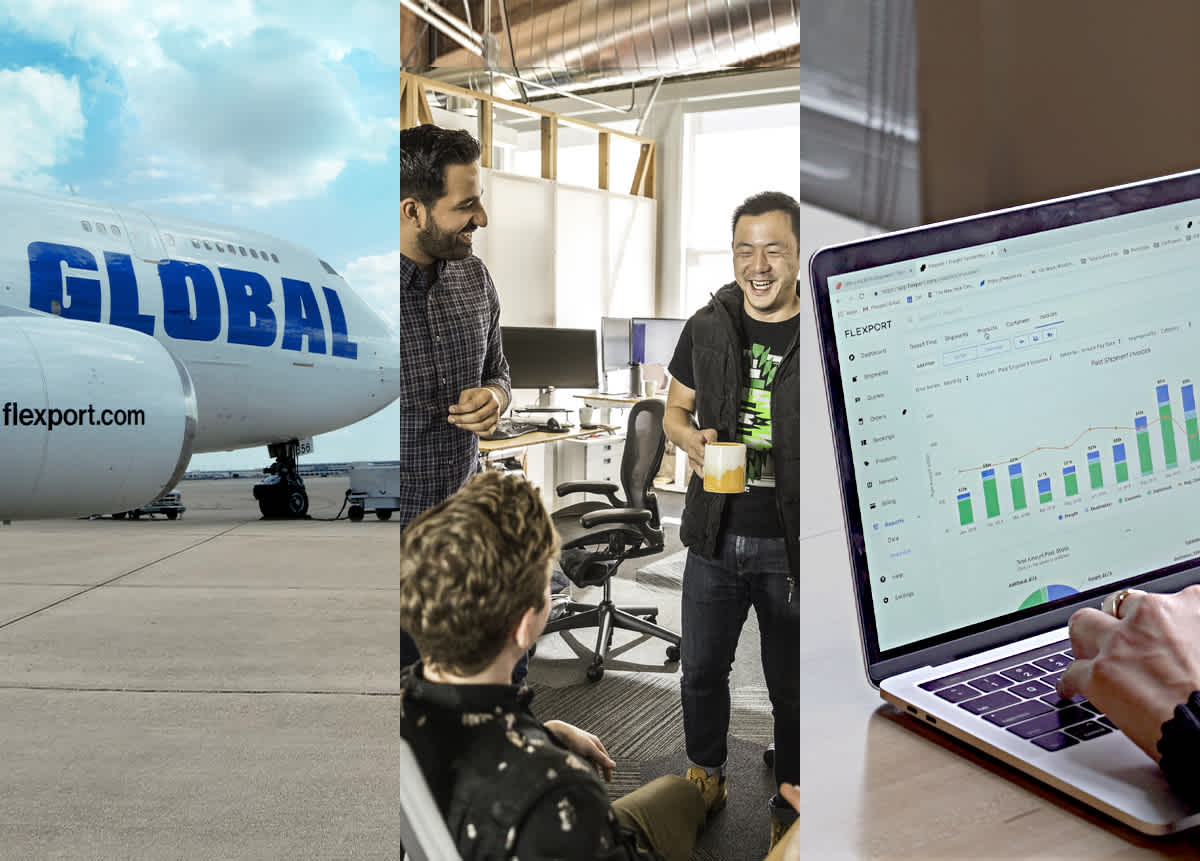
January 30, 2019
Cost per Acquisition Across eCommerce Marketplaces
Cost per Acquisition Across eCommerce Marketplaces
This blog post was originally published by Deliverr, which is now Flexport. The content has been adjusted to fit the Flexport brand voice and tone, but all other information remains unchanged. With the merging of Deliverr’s services (DTC fulfillment, B2B distribution, and Last Mile delivery) into Flexport’s existing international freight and technology services, we’re now able to provide merchants with true end-to-end logistics solutions spanning from the factory floor to the customer’s door.
You know your eCommerce business’ profits for the last quarter, average customer spend, acquisition costs and cart abandonment rates. You might even know your average customer lifespan. But what do you know about your customer lifetime value (CLV) and cost per acquisition for your store?
We’re going to explain everything that small eCommerce retailers need to know about CLV and customer aquisition.
We’ll cover the valuable customer information CLV exposes, the competitive advantages it brings, and how factors such as fulfillment, shipping, and loyalty programs can turn customers from one-hit-wonders into profitable lifetime regulars. Then we’ll move into marketplace costs, including referral fees, fulfillment fees, and advertising fees so you can make the best choices for your business.
With the competitive nature of eCommerce, smart sellers should take any edge they can get. Saving even cents per item can help bolster your margins as you grow your volume and business altogether.
On the flip side of the coin, spending too much on customer acquisition could ruin your business. eCommerce is constantly pushing the limits of what’s acceptable when it comes to cost-per-acquisition, with examples like Blue Apron spending $400 to acquire a new customer.
Making smart choices about where you spend your money can help you increase your runway and gives you more resources in your toolbox. Plus, every seller knows to pay attention to profits.
Back to Basics: What Is CLV?
Customer lifetime value (CLV) is the value that a customer brings to your business over their lifetime as your customer.
If you attract customers who only purchase from your eCommerce store once or twice, your CLV will be low. If you attract customers who regularly purchase from you, your CLV will be high.
Anything from shipping, engagement and website layout can increase your CLV, but more on that later. First, let’s explain why CLV is so important.
Why Is CLV Important?
Retaining customers is one of the most profitable things your business can do. Acquiring a new customer can be anywhere from 5 to 25x more expensive than retaining an existing one, and increasing customer retention by just 5% can increase business profits by a huge 25%. But CLV is more than just that.
- CLV is a long-term metric, helping you to improve the lifetime and success of your business.
- CLV identifies the customers who will bring you the most profit, enabling you to target your marketing spend, increasing ROI.
- CLV tells you what’s driving customer loyalty, helping you build on what works and keep customers away from your competition.
- CLV helps pinpoint what’s making your customers happy so that you can do it again.
- CLV helps predict customer behavior and target what’s pushing them away.
- CLV helps identify weaknesses in your business, such as product quality and customer engagement.
Savy eCommerce retailers then use all of this information to increase their CLV, becoming a competitive player in their respective markets and driving higher profits.
When you know your customer lifetime value, you’ll be able to judge it against your customer aquisition costs to see whether you’re spending too much or too little on getting new customers (more on that later).
How To Measure CLV
CLV can be a little tricky to calculate, with different algorithms and formulas all over the internet. Here’s a simple approach to calculating CLV:
CLV = customer value x customer lifespan
- Calculate your average purchase value (divide your total annual revenue by the number of purchases over that year).
- Calculate your average purchase frequency (divide the number of purchases over the year by the number of unique customers who purchased during that year).
- Calculate your customer value (minus your average purchase frequency from your average purchase value).
- Calculate your average customer lifespan (the average number of years a customer continues purchasing from you).
- Calculate your customer lifetime value (customer value multiplied by customer lifespan).
How To Increase CLV
How do you improve CLV without drastically increasing your costs or putting a strain on your already limited time? Here are 3 simple strategies.
1. Increase your average customer lifespan
New evidence suggests that by 2020 customer experience will overtake product and price as the key differentiator, making the following essential for increasing customer lifespan.
Fast and free shipping
Why do more than 100 million people pay for Amazon Prime? Because it offers fast and free shipping. 63% of online shoppers expect fast delivery as standard, something that can prove difficult when manually fulfilling your orders. Satisfy your customers’ shipping needs by using a fast fulfillment service with competitive all-inclusive rates.
Multi-channel selling
Have a low CLV but only sell on Amazon? That might be why. Use multi-channel selling to reach different customers and then drive those customers to your own online shop, where you can start building a relationship without distractions from your competition. If you’re concerned about handling the logistics of multiple sales channels in-house, use a listing tool and fulfillment provider that works across your sales channels.
Outstanding customer service
74% of millennials would stop shopping with a brand following poor customer service. Ensure that your deliveries are on time, any customer problems are resolved quickly and that all the information on your website is correct.
Early engagement
Follow up initial purchases with a post-conversion email that encourages customers to come back for more. Then, maintain regular customer engagement through personalized product recommendations, newsletters and loyalty offers.
2. Increase the number of times a customer shops from you
Once you’ve encouraged your customers to stay, you need to encourage them to purchase from you more frequently.
Increase touch points
The more touchpoints a customer has with your brand, the more likely they are to use you again. Diversify your sales mix by expanding beyond the Amazon marketplace into eBay, Walmart, Jet, and your own store and engaging with customers on social media and through dynamic remarketing.
Quick delivery
Being able to have an item delivered within two days, makes shopping with you easier. If you’re doing your own fulfillment, ensure that you can process your orders and get them to your shipping carrier promptly. Alternatively, use a reliable outsourced fulfillment partner to offer your customers fast, guaranteed deliveries.
Subscription models
The subscription box market is booming, and it’s an easy way to guarantee regular customers. Consider whether any of your products could be offered by way of regular and committed deliveries.
3. Increase the amount a customer spends with you
Once you’ve hooked your customer and increased the regularity of their visits, you’ll then want them to spend more.
Incentives
We all know that if you’re saving money, you’re likely to spend money. Incentivize your regular customers to spend more by offering free express shipping and minimum spend discounts. Appearing on the Walmart Free-2-Day Shipping and eBay Guaranteed Delivery programs are a great way to show your customers that this is a service you offer, especially if it’s something that your competitors don’t.
Upsell
“You know what shoes would go perfectly with those pants…”
Use product placement and personalized product recommendations on your website and email marketing to encourage customers to spend more on complementary and recommended products.
Product comparisons
Displaying product comparison information on your online shop allows you to showcase the benefits of similar but more expensive items, giving online consumers a chance to want something slightly better.
Factors When Determining Cost per Customer Acquisition
Now that we understand CLV, what about figuring out cost per customer aquisition?
Knowing your CLV will give you a good idea of whether or not the costs below are worth aquiring a customer on different channels.
Here are a few components to customer acquisition, including advertising costs, referral fees, and whatever brand marketing you want to do externally.
1) Referral fees
Referral fees are like a commission that marketplaces take on each sale. For example, if Walmart has a referral fee of 8% for cell phones, so Walmart sellers only get 92% of every cell phone sold.
In addition to referral fees, Amazon and eBay also have other fees to take note of.
- Amazon referral fees range from 6-20%, with most sellers paying 15%. Amazon also has a minimum referral fee of $0-2 if the referral fee is under the minimum for that category. Finally Amazon has different subscription fees for Individual ($0.99 per item) and Professional sellers ($39.99 per month).
- Walmart referral fees range from 6-15%, with their cheapest category being personal computers at 6%.
- eBay referral fees range from 6-9% based on category. eBay also has an insertion fee per store type; basic ($0.20), premium ($0.10), and anchor ($0.05).
Among the three marketplaces listed above, Amazon’s fee structure has the most complex components and number of categories. Amazon’s percentages also skew high compared to the other two marketplaces. Walmart’s fee structure is the most straightforward, and eBay’s referral fees are the most affordable overall.
eBay referral fees place them at one of the most affordable marketplaces to sell on. However, we also have to think about the level of competition on these marketplaces, as it’ll determine advertising expenses.
2) Marketing and advertising fees
There are various advertising options in Amazon, Walmart, and eBay.
All 3 marketplaces come with some form of pay per click advertising, where you can post sponsored products and only have to pay if someone clicks through or makes a purchase. Since you can set your budgets, this is also a way to control your ad spend.
However, having less competition can help your money go further when it comes to advertising.
As with their fee structure, Amazon has the most options and typically runs the most expensive. One Deliverr seller shared that they got bids from Walmart Performance Ads at about ⅓ the cost of similar keyword bids they were running on Amazon Sponsored Ads.
So Amazon comes out as expensive in regards to their referral fees and advertising costs, due to the high competition. However, they make up for this with FBA, which comes with some of the most affordable fulfillment costs available.
3) Fulfillment costs
With comparable referral and advertising fee ranges, much of your costs will come down to fulfillment, where Amazon FBA typically beats out the competition.
We did a cost breakdown of how much it would cost a seller to fulfill a cell phone case on Walmart 2-Day with Deliverr, Amazon Prime with FBA, and their own stores.
Overall, 2-day fulfillment is more expensive on other marketplaces than it is with FBA. The only issue here is that FBA doesn’t always play well with other marketplaces. Items arrive in Amazon-branded boxes, and multi-channel FBA comes with different fees and service levels from FBA for Amazon orders.
To combat high fulfillment fees while still staying competitive with fast shipping tags, we recommend partnering with Deliverr. You’ll get access to discounted Walmart 2-day rates, and we integrate directly into Walmart and eBay’s fast shipping programs. Calculate your fulfillment costs in our cost calculator.
Wrapping It Up
Compared to Amazon, the overall cost of acquisition is higher in Walmart, eBay, and your own stores due to fulfillment, but marketing costs are lower due to lowered competition. Your own store will be the most expensive when it comes to fulfillment and marketing.
CLV is the magic metric that provides you with invaluable customer information, sets you apart from your competition, fuels your sales and marketing strategies, and increases your profits. Plus, with fast shipping, customer discounts, and multiple sales channels, it’s easy to improve the value a customer brings to your eCommerce business.
To give yourself the greatest competitive edge, we recommend diversifying across marketplaces as well as having your own store. Keep costs low by investing more in the marketplaces with lower cost per acquisition, and keep fulfillment costs low by using FBA for Amazon and Deliverr for Walmart, eBay, and your own Shopify stores.
The contents of this blog are made available for informational purposes only and should not be relied upon for any legal, business, or financial decisions. We do not guarantee, represent, or warrant the accuracy or reliability of any of the contents of this blog because they are based on Flexport’s current beliefs, expectations, and assumptions, about which there can be no assurance due to various anticipated and unanticipated events that may occur. This blog has been prepared to the best of Flexport’s knowledge and research; however, the information presented in this blog herein may not reflect the most current regulatory or industry developments. Neither Flexport nor its advisors or affiliates shall be liable for any losses that arise in any way due to the reliance on the contents contained in this blog.



